
home

maglog

email

archive

radio

viridian

links

me
|
The extremely digestible

first quarter
second quarter - third quarter
- fourth quarter
my fave = my
fave
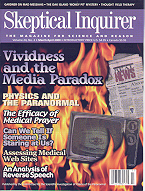 |
Skeptical
Inquirer: March/April, 2000
The Skeptical Inquirer is
published by the Committee for the Scientific Investigation of Claims of
the Paranormal. While the X-Files they are not, you could think of
SI as the magazine that Scully would write for. SI is written by scientists
who rigorously scrutinize research that claims to prove the paranormal
and the plain loopy. For example, in this issue SI carefully examines two
recent papers that claim that intercessory prayer (that's other people
who pray for you) provides therapeutic benefit to the ill and find that
one study was improperly designed and the other was "fallaciously analyzed".
This dry reading is shored up by other neat works: a recent history of
Messiahs, how some UFO buffs are expecting email from aliens, how the vividness
of media affects our perceptions of risk, and why theoretical physics shouldn't
be used to explain the paranormal. My fave piece was an investigation of
"The Secret of Oak Island" which can be found
in Nova Scotia's Mahone Bay. It's long been thought that there was treasure
on the island, but the author surmises that the "pirate tunnels" were natural
formations and that the story was influenced by the "Freemason's Secret
Vault allegory". I think The Skeptical Inquirer should be in every public
library, and perhaps every Academic Library as well. |
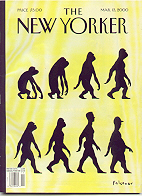 |
The New Yorker: Mar. 13,
2000
I don't normally pick up
the New Yorker but this issue had two things going for it: an
essay on The Pill by non-fiction It Boy Malcom
Gladwell and a profile on The Simpson's funniest
writer, George Meyer. What I learned: the Pill of today works by
fooling the body is pregant; a better drug may fool the body is in menopause
and reduce cancer risks. What I also learned: Meyer was picked for the
writing crew for The Simpsons from his work on a
zine called Army Man. As well, The New Yorker's critics look at photographer
Walker Evans, minimalist artist Sol LeWitt, three books on New Orleans,
and the movies 'Boiler Room' and 'What Planet Are You From?'. |
 |
UTNE
Reader: Mar-Apr 2000
The theme of this issue
is privacy and I like how they approach the topic from several angles.
There's a piece on how government distrust is eroding the participation
of the US census, the steps that one Quaker has taken to erase his official
identity, and how today's companies have divided the western world into
14 common lifestyles. The rest of the "Best of the Alternative Media" is
a hodgepodge of items on hemp, garbage, Gandhi, walking, Haiku Poet Richard
Wright, and Ira Glass. I don't know - the intended poetic moments of it
all were lost on me. |
 |
Outpost:
March / April 2000
Outpost is a lovely little
magazine about traveling the big blue marble for those travellers not afraid
of seeing both the beauty and the ugliness in lands far from home. In this
issue there are articles on the other side of tourism in Saint Lucia, being
kidnapped in Bangkok, miners in Potosi, Bolivia, travelling the world's
warzones with Doctors Without Borders, traveling in Hanoi, Vietnam and
spending New Year's alone in Northen Alberta. And there's a profile of
Elvez
to boot. Normally I don't like travellogues but I like Outpost. |
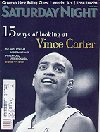 |
Saturday
Night: March 2000
The title piece is called
"15
Ways of Looking at Vince Carter". Will someone please tell me whether
this device is purely a Canadian phenomenon? I have seen "32
Short Films About Glen Gould" and have read in Queen's
Quarterly, "13 Ways of Looking at the Truman Show" (of
course, it's not). Regardless, it's a great device. For example,
SatNite looks at Vince as local hero, as cultural invader, as superhero,
as search topic, as download, as Torontonian, as a dancer, as armpit, as
TV image, as fashion statement, as atlas, as salesman, and as African-American.
There's also a profile (only one) on one of my personal heroes (because
I'm a "foot person") Jane Jacobs, author of "The
Death and Life of Great American Cities", a look at how high-tech is
changing the face of Ottawa, and a sympathetic article on the graffiti
artists who use trains as their canvases. I say 'sympathetic' because it
would be easy to write off these kids as "territorial pissers" (as
I am sorely tempted to do myself) but the author does a good job coveying
the love of graffiti that these kids have as well as their need to connect.
That's why I read Saturday Night. It connects. |
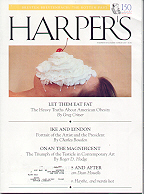 |
Harper's
Magazine: March 2000
It's a strange issue of
Harper's this month. The cover article presents a
short but strong argument that obesity should be made a larger concern
in America especially as most of the country's obese are poor and
unhealthy. What follows is a weird jazz-like riff on Lyndon Johnson and
an "Outsider Artist" Ike Morgan. I initially skipped "Confessions
of a Lapsed Oboist" because it sounded deadly boring, but when I
started it I found that it was a great diatribe against who the author
calls the "Music Is My Bag" people - or who I used to call "The Band People"
when I was in school. Canada's own culture-slut, Mark Kingwell, contributes
a review of Walter Benjamin's Arcade Project. Then, there is such an enthusiastic
and glowing review of the work of Matthew Barney - a video artist who's
art is a testimony to the testicle - that at first, I thought the author
was being sarcastic. I haven't been mentioning the monthly
map feature of Harper's, but I'm starting now: on the back page there
is a map of the hate groups of America. |
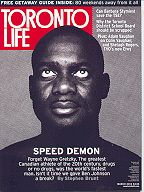 |
Toronto
Life: March 2000
Not surprisingly, most of
this issue is unabashedly about Toronto: a profile of Colin Vaughan by
his son, an argument why the Toronto District School Board should be scrapped,
a profile on the neighbourhood of Gloucester, and a write-up on the president
of the Toronto Stock Exchange, Barbara Stymiest. But the cover story should
be understandable to most Canadians: it is an argument that - drugs or
no drugs - Ben Johnson should be considered the greatest Canadian athlete
of the 20th century. Personally, I found the argument weak but the author
does make a good case that perhaps we should be more sympathetic to the
man. We now live in a world that doesn't seem to mind Mark McGwire's
performance enhancers and no longer holds the IOC as a credible bearer
of ethics. Maybe now is the time to forgive Ben Johnson. |
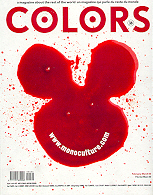 |
COLORS:
February / March 2000
The theme of this issue
of COLORS is monoculture - something that the cover doesn't really convey
very well. But inside is good, standard COLORS fare. What I learned:
there are serious and deliberate efforts being taken to make the global
palate uniform and blander. Another: chewing gum was banned in Singapore
not because of litter but because political prisoners were using gum to
block automatic doors on metro trains. How can this magazine, which is
funded by a global clothing company (Benetton), find a safe irony-free
place to criticize monoculture? Their answer is from a reprinted excerpt
from their first issue: "While COLORS is being distributed globally, in
five bilingual editions, we feel funny about being global. It makes us
feel like we're McDonalds and we're not. We don't want to sell our culture
to you. We want us to tell us about your culture." Regardless of whether
you believe that, reading COLORS will add spice to your monoculture world. |
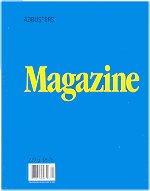 |
Adbusters:
Spring 2000
There's a loose theme of
suburbia to this issue. There's a criticism of landscapers, of teenagers
and suburbs ("telling quote: "In the aftermath of the Columbine High School
tragedy... it seems to me that the finger of blame should be pointed back
at us and where we live - the track housing developments") and an interview
with Geography
of Nowhere author, James H. Kunstler. I have had a long standing
interest in the relationship of suburbia and the culture it creates but
I found the articles lacking: they were simply too short. They were more
like vignettes than arguments. That's what's so weird about Adbusters these
days - space that would have been dedicated to words are now used in expansive
photospreads. It's as if the magazine is a testimony to the image rather
than the word - which is a pretty weird impression of something called
"Adbusters". |
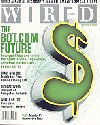 |
WIRED:
March 2000
I'm simply just going to
stop talking about not buying WIRED ever again because its obvious that
I'm hopelessly addicted. Before all its content, WIRED has placed a special
report on Microsoft and how even in the light of the upcoming favourable
ruling for the DoJ, the CEOs of Silicon Valley are too afraid to testify
against Bill. Other articles cover speculation of how bots will change
e-commerce, Missyplicity : a project to clone a beloved dog, another start-up
story : this one from some Harvard undergrad, the guys that are still faithful
to their TRS-80s and their Commodore 64s, and how Rupert Murdoch is taking
to the Net. There are also smaller bits on India's silicon valley, Bangalore,
on the folks who create their own nations, and a photospread on high-tech
bicycles, which thrilled Ghengis - so I'm assuming it's good. |
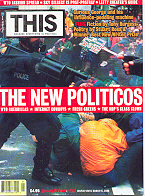 |
This
Magazine: January / February 2000
This issue of THIS wasn't
nearly as fine as it's previous issue, but that would have been a pretty
tall order. Surprisingly, there's not much on WTO but what's there is priceless.
THIS found out that some days after WTO, Glamour Magazine had left a message
with the Toronto office of TAO Communications - a cooperative of
cultural workers and activists - saying that they were looking for women
(between the ages of 20-35) to profile. As a response, THIS
has made a protester's style guide ("A made-at-home antidote to
tear gas and pepper spray involves a quick and easy solution of baking
soda and vinegar"). There are also snippets on futurist George Gilder,
a guide to the Left in Canada, and a lefty Christian timeline. Articles
include Sky Gilbert explaining the "End of Gay" movement and other explainers
on Hacktivism, the BC Green Party and the BC NDP party (can't really say
much about these: I don't think I can ever understand BC politics). |
 |
Shift
Magazine: March 2000
As the cover attests, this
is an issue of lighter fare. Smaller items include a top ten porn list,
a profile on the creator of Fametracker
and
Hissyfit, a story of teaching
Hassidic women the web, a simplistic piece on world population forecasting,
the Annual Singles convention that was held in the Silicon Valley, and
an introduction to Third Voice. The only item of length in this issue is
a profile on Theresa Duncan who has created three CD-ROMs (including Chop
Suey), a film called "The History of Glamour", and is now being paid to
come up with ideas for new VH-1 TV shows. Why is this deemed worthy of
a profile? Well, she's also "model-beautiful" and has a New York movin'
and shakin' lifestyle. So there. Well, at least I can be comforted that
she didn't get the cover photo: that was saved for a Bill Gates impersonator
(who also gets his own profile). So while I have misgivings of this month's
profile choice, I still liked Shift-lite. Everyone needs a good slack from
time to time, especially the New Media. |
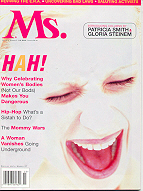 |
Ms.
Magazine: February 2000
Unlike other women's magazines,
Ms. spends space on disadvantaged women from around the world - women who
still don't have the right to vote or own property or marry and divorce
independently (as a very nice touch, Ms. provides addresses like Amnesty
International, so that one can write to the responsible governments in
protest). In light of these gross injustices, Ms. can only address the
serious issues that still affect North American women, such as those addressed
in this issue: a lawyer who visits battered women in their homes, underpaid
part-time faculty (who are mostly women), author
Natalie Angier - author of "Women:
An Intimate Geography", going underground to escape a dangerous ex-husband,
and how the media handles motherhood. What I mean to say is, Ms. can never
be as frivolous as Bust or as mindless as other women's magazines which
makes Ms. less fun to read but all the more important. |
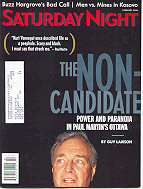 |
Saturday
Night: February 2000
It's a thin issue of Saturday
Night with only two substantial articles. The cover story is about covering
the story of Paul Martin's non-leadership bid for head of the Liberal Party.
Evidently, if Paul Martin even mentions that he has any ambition
to be the next Prime Minister, it pisses off Cretien and causes him to
take action against Paul. This is the context for the ensuing dance of
words between Paul Martin and author, Guy Larson. The second piece profiles
the men who defuse land mines around the world. From the "It Came From
Canada" department: we gave the world the white line that separates the
lanes on the road. |
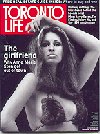

|
Toronto
Life: February 2000
Frank
Magazine: January 12, 2000
It's Trophy Wife Night in
Canada. TOLife profiles Canadian gold-digger Anne-Marie Sten in an oddly
sympathetic and not unkind manner. Frank Magazine, which is always unkind,
really doesn't have much to add about Anne-Marie and (Marlen)
other than that they've recently joined a weight-loss ashram. TOLife also
has some fine little pieces on such Toronto fixtures as the TheatreBooks
bookstore, public radio station CJRT, Fifth Wheel truck stops, and Rochdale
College. For more sorid reading, there's the story behind the Loomis heist
and the 1999 Toronto Murder Map. In Frank, the best read is the gossip
behind all the nation's major papers. The "Top 100 Wankers" is disappointing
- there's not even 100 in the list, which says volumes about the present
level of celebrity in Canada. |
 |
Harper's:
February 2000
The bulk of this issue is
taken up by two articles on George W. Bush. The first
follows the money that follows "W" and it's a pretty damning account
that the money-power relationship is more causation than correlation. The
second article reviews the restoration of the Bush legacy from a historical
standpoint and concludes that if it is to be like previous restorations,
"W" is guaranteed to disappoint. There's a "letter" from Belarus and a
story from Jack London from the archives. Ending the issue, New York: A
Documentary Film (PBS) is reviewed and dissed as the city is "treated like
a celebrity". I preferred the reviews of books dealing with marriage which
subscribe to my notion that marriage is a separate matter from romance
altogether. |
 |
WIRED:
February 2000
I was just about to swear
off WIRED, but as January was a dry month magazine-wise, I broke down and
picked it up. I was surprised; this issue didn't disgust me. The cover
article on "cybernetics pioneer Kevin Warwick" is breezy and speculative.
The article that follows the New York Times Digital division bid for an
IPO is a good one too. It asks what are the ramifications of digital reporters
getting lots of cash and leaving the "traditional" journalists none the
richer. There's a profile of TED conference holder, wunderbrat Richard
Saul Wurman (canuck alert: watch out for ads for TEDCity)
and of a new search engine called Autonomy. The only thing that really
soured me was the piece on how dot.coms were using brassy commercials during
the Superbowl (nothing can get me to watch football, certainly not commercials).
Word watch: two WIRED articles make use of the phrase "skunk works" which
Merriam-Webster
tells me, originated from Al Capp. Hey, that makes two independent references
to
Li'L Abner! It's an official trend! |
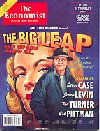 |
The
Economist: January 21, 2000
It was years until I actually
gave the Economist a fair chance. With a name like The Economist,
I always had it figured as a business rag. But once I actually gave it
a fair shake, I realized it was clearly the best news magazine out there.
Time Magazine, USNews, and Newsweek can't hold a candle to the Economist's
superior writing, analysis, and dry wit. I don't read the Economist regularly
though. Actually, I couldn't if I wanted to: The Economist cranks out more
than a hundred pages of small print fortnightly (it is British, you know)
on politics and economics with no arts or entertainment filler. I'm still
working through this issue. |
 |
The
Wealthy Boomer: Volume 2, Issue 1
God, I loathe this magazine
(let me count the ways). Sure, it's supposed to "In pursuit of wealth,
wisdom, and well-being" but with like "Wealthy Boomer" you know that it's
all about the loonies. Indeed, most pages deal with taxes. Trouble is,
in order to shore up such a boring topic, most of the writers use metaphors
that are ludicrous and almost to the point of being offensive. An example:
in the article that complains about the poor selection by the provincial
government-run liquor board the author states that "it's like having Joseph
Stalin as your personal sommelier" (suffer the little boomers) The "well-being"
articles are laughable. Out of shape? Hire a personal trainer. Stressed?
Go to a spa. And did you know there is money in Beatles collectibles? This
magazine is for those sad "Atlas Shrugged" admirers; those who think that
as they are the "finest brains" they should not have to suffer "economic
enslavement". Don't trust anyone over 40. |
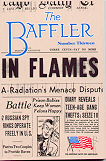 |
The
Baffler: Number 13
The New Economy celebrates
the goatee wearing dot.com IPO'd CEO. But it didn't always use to be this
way. In fact, it wasn't so long ago when the hero of the right was the
average joe, the self-made man that made up the "silent majority" of right-wing
populism. This issue of The Baffler examines "the personalities and movements
and ideas that made right-wing populism possible". Like the Legionnaires
(who actively fought those not with '100 percent Americanism'), Reader's
Digest (who worked with the CIA), Li'L Abner (a
comic that was the people's own until Al Capp seemed to switch sides),
Hilton Kramer (crotchety art critic), and the John Birch Society (an organization
that went from anti-communist to anti-UN). The issue is a good history
lesson and a good reminder that populism - both left and right - has been
readily fading in the thirty years, and is almost gone from sight. |
 |
Whole
Earth: Winter 1999
This issue's theme is fire,
and that's fire in a physical sense, not a metaphorical sense. Articles
cover fire in the watershed, burning through the ages, fire fighting, fire-loving
species, how cells "combust" metabolic fuels, the Need Fire (a community
fire jumping ritual), Burning Man, a story of arson, the Hindu myth of
the marriage of Shiva and Uma, the hearth, a history of ignition, cooking
with fire, the fire of hysteria in New York 1741, burning libraries and
churches, restorative fires, and green chemistry. Yeah, it's a granola
magazine, but it is in the truest sense of the word: it's a hearty mix
of stuff that's good for you. |
 |
Harper's:
January 2000
Harper's commemorates the
year 2000 with "The Index of the Millennium" which means that there are
three pages of odd facts as opposed to the regular one page. But the real
commemoration is the feature article, "The Unfinished
Twentieth Century" which argues that culturally the century
will not end until we put away our nuclear weapons. Another fin de sicle
piece is the discussion of privacy in the electronic age which covers some
of the problems but fails to recommend any solutions other than learning
to "hide in plain sight". My favourite bit of the magazine was from the
"Readings" section: a reprint of some of the electoral statements from
Britain's House of Lords. Those dudes are weirder than Monty Python. |
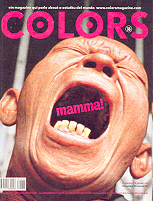
|
COLORS:
December 99 / January 00
Normally I would give default
orders to pick up COLORS if you see it, but these are strange days: I suggest
to give this issue a miss. This issue's theme is 'mother' and its really
tempting to give a Freudian analysis of their treatment of the subject
as all their coverage is dark and negative and there's really nothing positive
at all... pages spent on infancide, but none on lullabies. There are 'shocking'
images (used tampons, crotch shots, dead babies) but no 'enlightening'
ones that surprise us. I think it's telling that COLORS treats kitchy objects
with more bemused respect than moms. My sister said that this issue was
a real downer and I couldn't agree more. |
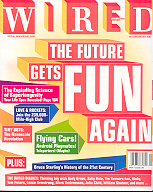
|
WIRED:
8.01 : January 2000
Ok, I vowed never to pick
up WIRED again but then I saw this issue and said, hey! there's no loving
profile on some venture capitalist... it's all dedicated to future speculation.
So I gave WIRED another chance, largely because it featured an article
by Bruce Sterling, who, in my eyes, does no wrong when writing magazine
pieces. His vision of a viridian 21st
century New York - filled with modular buildings made from bamboo - was
no exception. Unfortunately, no other writer crafts a future in this issue
as well. What's more, there are three articles that expounds space travel
just because there's a market for taking millionares into space. WIRED's
future? Same as it ever was. |
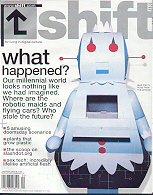
|
shift:
Jan/Feb 2000
Well, the year 2000 is almost
upon us. And the question that everyone is asking is: "WHERE ARE THE FREAKING
ROBOTS?" The cover article of this issue of shift looks into the future
by looking into our past through previous World Fairs. Unfortunately, not
much is gleaned other than that previous designers loved a streamlined
look and the space program ended up being a lot more boring than expected.
While the other feature articles are better, they cover territory that
is not exactly new to the net-savvy: slashdot
and McSweeney's. On a more positive
note, the magazine looks beautiful and has some great items such as a photo
spread of the Vintage Computer Festival and a synopsis of recent French
music. |

|
Canadian
Geographic: 2000 Annual
If you are a Nuck (short
for Canuck; 'nuck' is slang not found in the real world but in David Foster
Wallace's Infinite Jest; I want to introduce it into the wild) or if you
love maps, then pick up this issue by gum! All the articles in this 134
page annual is related to mapping and in so, covers cognitive maps, mapping
history, what happens when a city is taken off a map, talking maps for
the blind, animal navigation, navigation by song, misadventures in mapping,
Geographical Information Systems (GIS), the Nisga'a land claim, mapping
space, mapping green-space, mapping lake bottoms, mapping the carbon sink,
and even more. And, to boot, it includes a map of Canada which features
our newest territory, Nunavut. Mine is on already on my wall. |

|
Adbusters:
Winter 2000
"The journal of the mental
environment" uses works of fiction to bring about the paradigm shift that
(they think) we so desperately need. One work tries to portrays the emptiness
of a decadent road trip and the other recounts a before and after transformation
of a soul-dead Australian businessman. With mixed results. One essay twists
the 'you deserve it' message of advertising to ask 'how much do I deserve?'.
The strongest article, IMHO, is by editor Kalle Lasn who laments the 1886
decision that entitled corporations the same rights
as people. Also included is a photospread of notable revolutions
(since the sixties) just to remind the reader that no one saw these revolutions
coming. So do not despair if you think that the upcoming post-consumer
revolution seems beyond reach. Adbusters assures that they could just be
behind the next corner. |
the
rain barrel
extremely
digestible maglog
or
the
1999 rain barrel
extremely
digestible maglog archive
|




